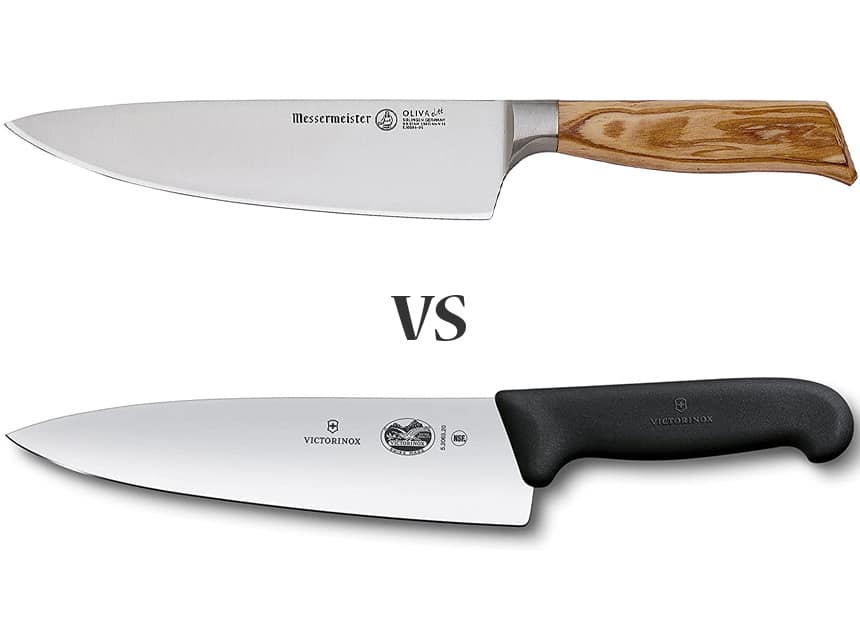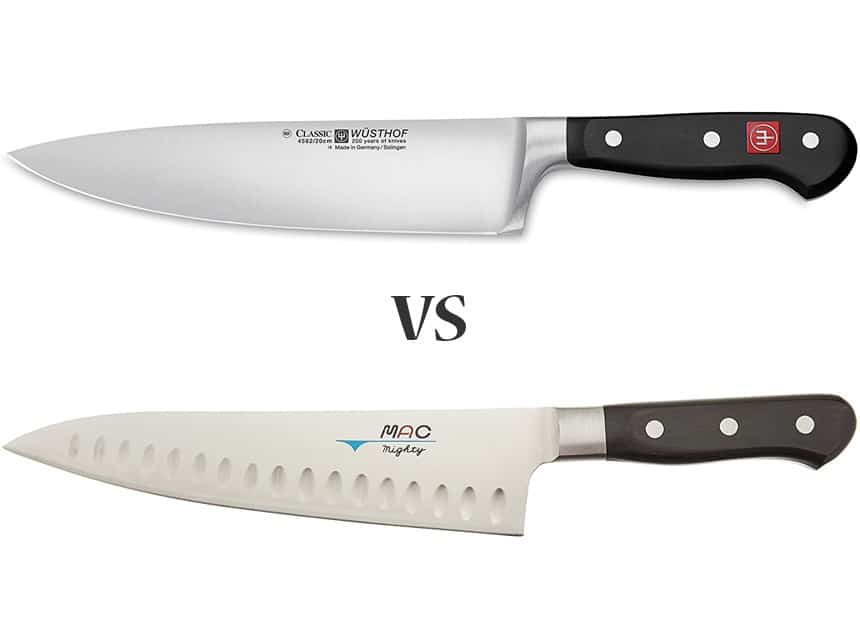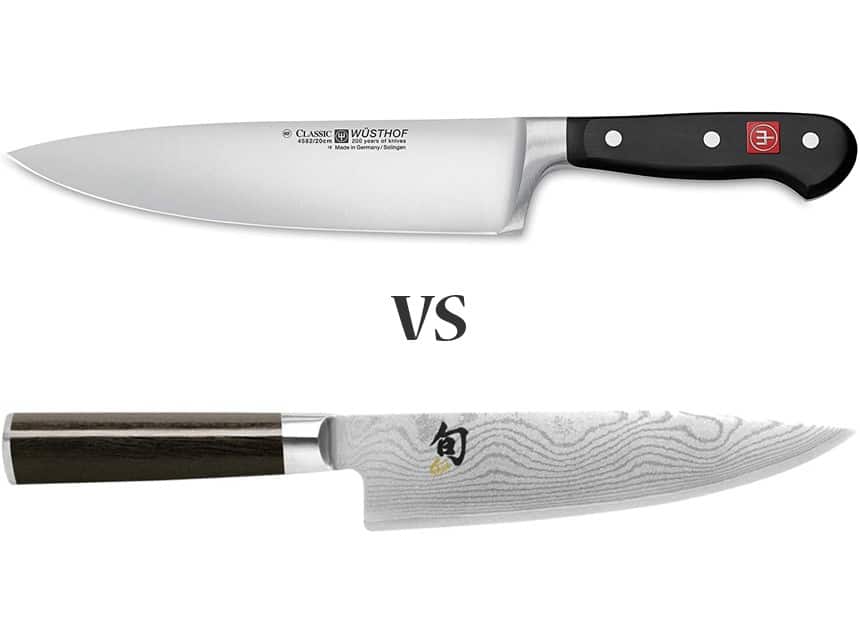
Kitchen knives come in an array of different designs and prices.
Two brands that rest on very different ends of the price scale are Messermeister and Victorinox.
In this article, I’m going to tell you the differences between these two brands.
I’ll go in-depth into the details of each, talking about where they are made, what materials are used and the difference in price.
This article should provide all the information you need to select the right knife for your needs.
If you ignore the price and focus on quality, Messermeister knives are unarguably better. They are built for extreme durability and use both classic and beautiful designs. However; that is reflected in the price and you can still get a quality knife from Victorinox for a third the price of a standard Messermeister. If you’re on a budget then Victorinox offers some of the best value knives around.
| My recommendation | Current price |
| Messermeister Oliva Elite 8-Inch | View on Amazon (opens new tab) |
| Victorinox Rosewood Chef’s Knife 8-Inch | View on Amazon (opens new tab) |
Messermeister vs Victorinox – Comparison Table
Here is my summary comparison table for each brand. This is mostly based on their most popular knives; the Messermeister Meridian Elite and the Victorinox Fibrox Pro Chef’s Knife.
For a more in-depth look at each category then check out the rest of the article below.
| Category | Messermeister | Victorinox |
| Country of Manufacture | Germany | Switzerland |
| Steel type | X50CrMoV15 (1.4116) | X50CrMoV15 |
| Rockwell hardness | HRC 57 | HRC 56 |
| Factory edge | 15 degrees (double bevel) | 15 degrees (double bevel) |
| Handle material | POM (thermoplastic) | TPE (thermoplastic) |
| Price range | $150 – $170 (Meridian Elite) | $50 – $60 (Fibrox Pro) |
| Main benefit | More durable, higher quality, stylish | Low price, comfortable design |
| My recommendation | Messermeister 8-Inch Meridian Elite (view on Amazon) | Victorinox Rosewood Chef’s Knife 8-Inch (View on Amazon) |
Messermeister vs Victorinox – Where are they made
| Brand | Country of manufacture |
| Messermeister | Germany |
| Victorinox | Switzerland |
Messermeister Knives are produced in the German city of Solingen, where they have been produced since their launch in 1985.
Messermeister is German for Knife (Messer) Maser (Meister), they have always had a focus on innovative design whilst still being influenced by German classics.
Bernd Dressler, the founder of Messermeister was the first western knife maker to introduce a bolsterless heel to his knife range, a trend that is found throughout western knives today.
Victorinox produces all their knives in Ibach, Switzerland.
Victorinox are a very interesting company as they are the original creators of the Swiss Army Knife, in fact they produce around 45,000 Swiss Army Knives every single day.
The company was founded in 1884 and since then has expanded into other products such as chef’s knives and watches.
I think the practicality that you’d expect from a Swiss Army Knife is reflected in many of the features of Victorinox’s kitchen knives, which certainly focus more on durability than sharpness, but we’ll come to that next.
Both of these brands have good heritage and have long been making durable blades, you can be assured that both these brands offer plenty of knife making experience.
Messermeister vs Victorinox – What steel do they use
The first thing to know is that Messermeister and Victorinox actually both use the same steel for their knives, at least in their main range.
However, the way the blade is formed does still make a significant difference between the two.
| Brand | Steel type | Rockwell hardness |
| Messermeister Meridian Elite | X50CrMoV15 (forged) | HRC 57 |
| Victorinox Fibrox Pro | X50CrMoV15 (stamped) | HRC 56 |
Both these knives use the same steel, X50CrMoV15. However, there is a difference in their Rockwell hardness, with the Messermeister knife being the harder of the two.
The main reason for that is that Messermeister blades are forged and Victorinox blades are stamped.
Both Messermeister and Victorinox use X50CrMoV15. It’s a German steel that is popular amongst producers of quality western-style knives. Messermeister uses forged steel for its knives whilst Victorinox knives are usually stamped.
X50CrMoV15’s large benefit is its durability, and that’s why it’s so popular with many European knife brands.
The main elements of interest within X50CrMoV15’s composition are Carbon, Vanadium and Chromium.
The Carbon content is around 0.55%. That’s not particularly high when comparing it with other quality knives; however, it’s high enough to provide sufficient strength in the blade for a 15 – 20 degree angle on each side, which is standard for western knives.
The big benefit of not having a very high Carbon content is that higher Carbon steels are usually more brittle, therefore the 0.55% content keeps the blade durable.
That’s the same with the strong Vanadium of 0.4%, Vanadium improves the resistance to wear of the steel also adding to its durability.
The Chromium content is 15% is what the 15 in X50CrMoV15 represents. Chromium is vital for the durability of steel as it’s what makes stainless steel resistant to rust.
Steel need only be 10.5% to be considered stainless, so a 15% content is high and makes this a quality stainless steel, very unlikely to rust unless extremely mistreated by the owner.
There is a difference in the Rockwell hardness (HRC) between the Messermeister and Victorinox knives.
Messermeister knives tend to be forged, that’s when steel is heated to a point it can be moulded.
Victorinox knives tend to be stamped. This is when the blade is stamped out of a flat sheet of steel, like a cookie cutter.
Typically forged blades are regarded as better and harder, resulting in the difference on the Rockwell Scale we see here.
However, stamped blades are significantly less expensive, and Victorinox knives still receive the benefits of durability that X50CrMoV15 provides.
Most people would agree that the forged steel of the Messermeister is better, although as a result there is a significant price difference between the two.
Messermeister vs Victorinox – How sharp are they
Once again I’m going to focus on the most popular knives from each brand for this comparison. That’s the Messermeister Meridian Elite and Victorinox Fibrox Pro.
You will experience a similar sharpness initially between both Messermeister and Victorinox. However; Messermeister knives will hold the edge for longer due to the steel being harder.
| Brand | Factory edge | Rockwell hardness |
| Messermeister Meridian Elite | 15 degrees (double bevel) | HRC 57 |
| Victorinox Fibrox Pro | 15 degrees (double bevel) | HRC 56 |
Both Messermeister and Victorinox use the same type of steel for their main range. However, because forged Messermeister knives are slightly harder they will hold the edge for longer.
Messermeister Meridian Elite knives are measured as being harder than Victorinox knives, measuring 57 and 56 on the Rockwell scale respectively.
That means that whilst they use the same base steel, and are factory sharpened to a similar angle, Messermeister knives will be able to hold their edge for longer.
In reality that means you’ll need to sharpen a Victorinox knife more often than you would a Messermeister if you want to keep the edge as sharp as possible.
There isn’t a huge amount to choose between the two when measuring sharpness, but overall Messermeister wins in this comparison.
Messermeister vs Victorinox – What are the handles made from
The material used for handles is a vital and often overlooked feature of any knife.
A quality handle is often the sign of a quality overall knife. Handles need to be made from a durable material that can withstand all the heat and moisture fluctuations knives can experience in the kitchen.
Once again we’ll focus on the two main ranges from each brand, the Messermeister Meridian Elite and Victorinox Fibrox Pro.
| Brand | Handle material |
| Messermeister Meridian Elite | POM (thermoplastic) – Although other Messermeister ranges use stunning timber for the handle |
| Victorinox Fibrox Pro | TPE (thermoplastic) |
Messermeister use a thermoplastic material called POM (Polyoxymethylene) for their Meridian Elite knife handles.
Although, it is worth mentioning that Messermeister use some very attractive timbers for their other ranges such as Royale Elite (American Walnut) and Oliva Elite (Olive Wood) that are exquisitely beautiful.
But for now, let’s focus on POM as that is used by their main range. Materials like these are ideal for knife handles due to their extreme durability.
POM is specifically designed for high stiffness and stability, and being a thermoplastic means it’s also extremely resistant to temperature and moisture changes.
It’s a fantastic material to use for knife handles, that will undergo all sorts of pressures and it makes sense to use this material for your main range, which is usually your more practical range.
However, as I’ve mentioned above, Messermeister in particular has some stunning handles in their other collections. I particularly like the Olive Wood handle used in their Oliva Elite collection.
So, although their main range uses the same handle material, I’d say the exquisite timber used by Messermeister.
I’ll link to the Messermeister Oliva Elite Chef’s knife at the bottom of this article, it’s well worth a look.
It is worth mentioning that whilst Victorinox’s most popular range uses TPE, they also have a knife that uses a very attractive Rosewood timber, which is actually my personal Victorinox recommendation.
But as the TPE knives are by far Victorinox’s most popular, I’m focusing on that.
Thermoplastic materials like these are ideal for knife handles due to their extreme durability.
TPE has many similarities with POM in regard to it being durable, but it has more flex in it than POM.
As a result the TPE handle Victorinox use isn’t quite as tough as the Messermeister, but it does offer a good amount of grip.
Messermeister vs Victorinox – How much do they cost
Both these brands have wide ranges of knives all at differing price ranges.
To allow for a fairer comparison I’ve categorized three of their major ranges that represent their highest and lowest cost knives.
I’ve tried to compare similar knives, sticking to 8 Inch Chef’s knives or the closest equivalent they have in the range.
In brackets next to the general price range you’ll see the name of the range.
These prices are rough estimates. Prices do change over time but this is intended as a rough guide.
| Brand range | Messermeister | Victorinox |
| Premium | $170 – $190 (Oliva Elite) | Not Applicable |
| Standard | $150 – $170 (Meridian Elite) | $110 – $130 (Professional) |
| Value | $35 – $45 (Four Seasons) | $50 – $60 (Fibrox Pro) |
This is easily the main benefit of Victorinox knives over Messermeister.
Victorinox knives are significantly less expensive, except for the value knives.
Victorinox do focus on low priced knives and there are good reasons for the price difference.
Messermeister knives are better quality, and their Standard and Premium ranges both use forged steel and have more durable handles.
With that being said, Victorinox do offer very good value for money on their most popular range, the Fibrox Pro.
In summary I’d say Victorinox offers great value for money at the lower end of the price scale, and they are very close competitors for the best chef’s knife under $100.
But If I was comparing the two with a budget of more than $100, I would definitely choose Messermeister.
Messermeister vs Victorinox – What is the difference
Now that we have looked at the design, materials, background and price of these brands we can fully understand the difference, and you should be able to make an informed decision on which knife is correct for you.
The main difference between Messermeister and Victorinox knives is the price. Messermeister knives generally cost much less than Victorinox. However, Messermeister offers knives for far better quality and does justify the price difference.
| Brand | Main benefits |
| Messermeister | More durable, higher quality, stylish |
| Victorinox | Low price, comfortable design |
I like both these brands, but there is a clear difference in the average price and that’s because they are just not equal in terms of quality.
Messermeister is a name that’s synonymous with quality and durability. Their knives use classic and beautiful designs and are built to last.
Victorinox have focused on the more budget-friendly end of the price scale, and to be fair they do it very well.
Being the creators of The Swiss Army Knife, Victorinox are a company that knows a thing or two about making knives that do the job, but don’t break the bank. So it’s no surprise their Fibrox Pro knives offer good practicality and comfort, for a very low price.
Messermeister vs Victorinox – Which is better for you
The determining factor for which of these brands you choose really comes down to budget.
If you have over $100 to spend, I definitely recommend a knife from Messermeister over Victorinox. I think Messermeister offers some of the best western-style Chef’s knives within the $100 – $200 price range.
However; if you have under $100 to spend then Victorinox is certainly worth a consideration.
Victorinox are fantastic at making quality knives that are still budget friendly and use the exact same X50CrMoV15 steel as high end western knives, they just use stamped X50CrMoV15 steel instead of forged.
If you are on a tight budget, Victorinox is a strong contender for the best brand around $50.
And you don’t even have to compromise on style, check out my Victorinox recommendation below, it’s got a beautiful Rosewood handle and is still only at the $50 – $60 mark.
My Messermeister Recommendation

View the 8-Inch Messermeister Oliva Elite on Amazon (opens new tab)
For my Messermeister recommendation I’ve gone with one from their premium collection, especially the Oliva Elite collection.
This knife is stunning. I think it’s the most attractive western style Chef’s knife available.
The Olive Wood handle gives it such a beautiful finish that it really stands out from other knives.
Olive wood won’t be quite as durable as other thermoplastic handles, so you will have to avoid doing things like soaking it in the kitchen sink, because that’s clearly going to warp the wood over time.
But as timber goes, Olive wood is still a good material for knife handles, it’s hard and strong so it will be durable, it’s just hard to match the artificially created durability of substances like POM with natural materials.
It’s a great knife, so if you want to add a bit of beauty to your kitchen then there are few better choices than this Messermeister Oliva Elite.
My Victorinox Recommendation

View the 8-Inch Victorinox Rosewood Chef’s Knife on Amazon (opens new tab)
The Fibrox Pro, with it’s thermoplastic handle, might be the most popular Victorinox knife, but it’s not my personal recommendation.
For a similar price you can get the Victorinox Rosewood Chef’s Knife. It uses the exact same steel but has a beautiful Rosewood handle instead of the thermoplastic.
Rosewood is hard, so it’s still plenty durable, and I think the style it gives the knife is really hard to match at this price range. It certainly looks like a knife that would be more expensive than it actually is.
The handle shape is a classic design, along with the curve blade edge it’s ideal for rock chopping and is a lightweight knife overall.
For a knife around the ~$50 you’ll find it hard to find another knife as stylish and as high in quality as this one.

